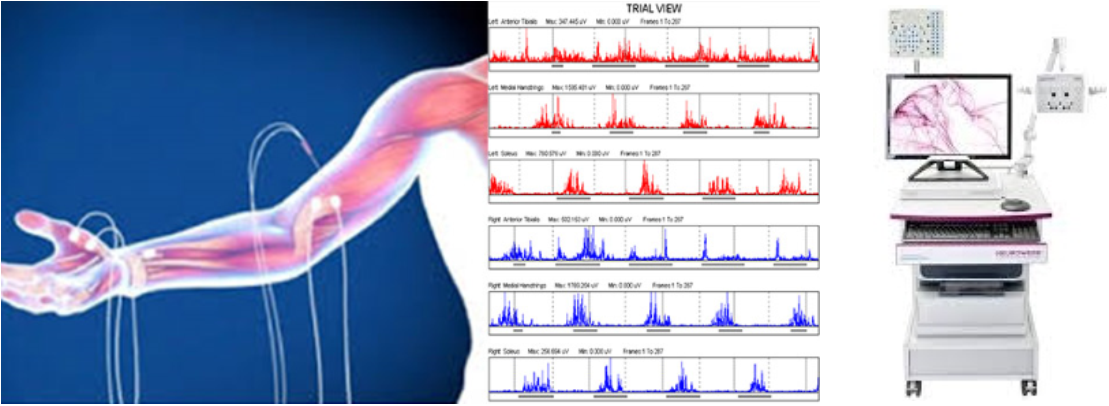Neurowerk EMG/EP Systems

A portable version or a complete in office/clinic (2 or 4 channel) neurophysiological measuring system for EMG, NCV and Evoked Potentials for use both in the clinic and in the doctor's practice, with a streamlined trolley.
The system provides the complete range of methods needed in the daily routine diagnosis of neurological functional disorders.
Straightforward intuitive operation combined with high time efficiency are just as much highlights of the system as the amplifier and high ADC resolution to record any electrophysiological signal you need.
Product Specifications
- NEUROWERK CENTER data base for EMG/EP and EEG system in a network
- Management of reported and unreported examinations for different users
- Database with presentation of patient and examination related information
- Automatic archiving of reported examinations on different volumes
- Backup for programs and data bases
- Interface to practice or hospital information systems
- Freely definable layout for all programs with individual window presentation
- Unlimited number of predefined examination programs
- Recording, storing, analysing, reporting and printing of
- EMG (Spontaneous activity, voluntary and maximum activity, with triggered MUP analysis
- Automatic Quantitative MUAP analysis (optional)
- Motor and sensory nerve conduction velocity, mixed nerve studies (CTS)
- F wave
- H reflex
- Blink reflex
- Repetitive stimulation
- SEP for Trigeminal nerve, upper and lower limbs
- Brainstem Evoked Response Audiometry BERA
- Middle and late latency AEP, Vestibular Evoked Myogenic Potentials VEMP (optional)
- VEP for checkerboard and goggle stimulation
- Sympathetic skin response
- Heart rate variation (optional)
- Single fiber EMG (available on request)
- Makro EMG (available on request)
- Magnetic Evoked Potentials MEP (Magnetic stimulator required)
- Collisions test, triple stimulation (optional)
- Tremor analysis o P300 examinations (optional)
- Averager with artifact suppression
- Split screen for on line, averaged and stored signals, presentation of results
- User defined report forms
- User defined number of measuring traces
- Automatic marking of pre-definable markers
- Graphic result presentation for nearly all examinations
- Sound presentation of the EMG
- EMG MUP analysis with presentation of single MUPs and averaged MUPs
- Quantitative EMG analysis with presentation of the recruitment and Turns/Amplitude analysis (optional)
- Freely configurable result table
- Printing of traces, result tables and report with standard printers
- Report generator for single examinations as well as for all examinations (summary report)
- Export of the report into PDF
- Power supply: 230/110 V +/- 10%, 50-60 Hz
- Power consumption: max. 400 VA
- Classification: Class IIa according to MDD, Annex IX
- Quality standard:
- EN 60601-1 Class II, Type BF
- EN 60601-1-2
- EN 60601-2-40
- Personal computer:
- Intel Core i3 2120 3,3 GHz
- 4 GB RAM
- 500 GB HD
- network 10/100/1000 Mbit (RJ45)
- CD/RW or DVD/RW
- 23″ TFT Monitor (min. 1280x1024)
- Keyboard, mouse
- Archiving/Backup: Integrated DVD/RW drive or via network
- Remote service: by Internet (TeamViewer)
- Interfaces (PC):
- Power supply
- Audio output (for additional multimedia speakers)
- LAN Ethernet 1 (EMG processor adapter)
- LAN Ethernet 2 (network adapter)
- Keyboard, mouse, monitor
- Interfaces (EMG processor):
- Power supply
- LAN Ethernet (PC)
- Amplifier/ADC
- 2x external Trigger In/Out
- Head phones
- VEP monitor
- Current stimulator (2nd current stimulator - optonal)
- Foot switch
- Operating System (PC): WINDOWS 7 prof.
- Trolley: with integrated isolation transformer 400 VA (1000 VA optional), keyboard drawing, lockable wheels, headbox stand
- Printer: WINDOWS compatible ink jet or laser printer optional)
- Amplifier:
- Sampling rate 50 kHz/channel
- ADC 24 bit
- Resolution 10 nV/d
- Channels 2, 4
- Max. Input voltage 25 mV o Noise < 1 μV pp @ 2 Hz-10 kHz, shorted input
- Input impedance > 110 MOhm
- CMRR > 110 dB
- Lower cutoff frequency 0.02 Hz - 1000 Hz in 15 steps; 0.02, 0.05, 0.1, 0.2, 0.5, 1, 2, 5, 10, 20, 50, 100, 200, 500, 1000 Hz); 6 dB/Oktave
- Upper cutoff frequency 20 Hz - 15 kHz in 11 steps; (20, 50, 100, 200, 500 Hz, 1, 2, 3, 5, 10, 15 kHz); 6 dB/Oktave
- Notch filter 50/60 Hz
- Temperatur measurement 20-40 °C, with temperature probe (optional)
- Impedance measurement: 0-100 kOhm @ 10 Hz in 0,1 kOhm steps; Presentation numerical or color coded
- Electrical stimulator:
- Numbers: 1 o 2 (optional) integrated electrical stimulators, external stimulators (optional)
- Stimulation current: 0 - 100 mA; in 1 mA steps
- Stimulation duration: 50 μs - 1 ms; in 50 μs steps
- Stimulation type: Single, double, train
- Stimulation frequency: manual, 0.1 - 100/s in dependence of the examination program
- Parameter setting: With keyboard, mouse or functional keyboard (optional)
- Display: Display of stimulation current, stimulation puls width and stimulation type on screen
- Acoustic stimulator:
- Stimulation type: Klick, Klick-Klack, Tone pips of all relevant frequencies
- Stimulation frequency: manual, 1 - 100/s in dependence of the examination
- Sound pressure: 0 - 124 dB SPL, in 1 db steps
- Stimulation duration: 50 μs - 1 ms; in 50 μs steps
- Stimulation polarity: Condensation, rarefaction, alternating
- Overlapping: White noise with adjustable intensity
- Parameter setting: With keyboard, mouse or functional keyboard (optional)
- Visual Stimulator:
- Stimulation type: Checkerboard, pattern flash, onset/offset, Picture stimulation, visual P300 (optional)
- Pattern: Checkerboad, vertical and horizontal stripes, pictures; variable size
- Stimulation field:Full, half, quarter field
- Fixation point: different fixation points, colored bitmaps, variable position
- Pattern color: black white, 16 grey steps
- Monitor: 17″ TFT monitor, 19″ or CRT if requested (optional)
- LED goggle (optional): left, right, booth eyes stimulation
- Environment conditions for operation and transport
- Operation: +15 - +40°C, relative humidity 20 - 80%, not condensing
- Transport: -20 - +60°C, relative humidity 20 - 80% not condensing
